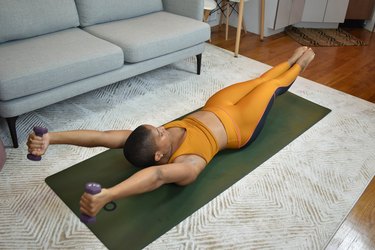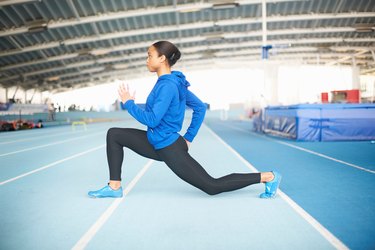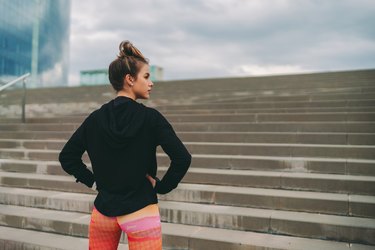

Although rheumatoid arthritis (RA) can cause joint pain and stiffness, it doesn't mean that you need to avoid exercise completely. It would actually be a big disservice to your health if you avoided working out altogether.
Exercising can be safe for people living with RA if you choose safe exercises and listen to your body. Try this 20-minute low-impact workout and learn more about exercising safely with arthritis.
Video of the Day
Warning
Before you try any new exercise program, make sure to consult a doctor to confirm it's safe for your overall health.
How to Do This Workout
Designed by Kimberly Steinbarger, PT, a physical therapist who specializes in RA and lives with the disease, this 20-minute low-impact workout helps strengthen the muscles around your joints to improve your range of motion. Plus, these exercises are highly functional and mimic many movements in daily life.
First, do the warmup for 5 minutes, then do 3 sets of 8 or fewer reps for building muscle strength. But if your goal is muscle endurance, do 3 sets of 15 or more reps.
"Regardless, people should start where they are at. If they can only do 2 reps, do 2!." Steinbarger says. "The important thing for people with RA is to be able to modify the exercise. If they're having a flare, they might need to tone it down a bit."
Things You'll Need
- 1 long resistance band
- 1 chair
The Warmup
Because people with RA tend to have sensitive hands, ankles and feet, it's important to warm up these areas with some stretching before your workout, Steinbarger says.
Repeat the stretches below as needed.
1. Ankle Stretch
- Sit on the ground with your legs extended in front of you.
- Point your toes away from your body and then flex your toes back up.
- Continue pointing and flexing your toes.
2. Wrist and Finger Stretch
- Extend your arms out in front of you and make a fist with your fingers, pulling your hands down until your knuckles are facing forward.
- Then, open your hands and spread your fingers wide to press an imaginary wall in front of you.
- Repeat, making a fist with your fingers and pulling your hands down until your knuckles are facing forward.
Warning
Stop exercising if you feel any sharp pain or have high levels of pain within 24 hours of your workout. It's normal to feel some discomfort trying a new exercise or 48 hours after your workout. But this discomfort should gradually fade after 2 to 3 weeks as your body adapts to the movement. Talk to your doctor or physical therapist before you start a new workout.
The Workout
1. Squat
Squats are an excellent exercise for people with RA because they strengthen your quads and glutes, which will help take pressure off your knees and works some ankle mobility. It also helps make it easier to sit down on a chair and stand up, Steinbarger says.
- Stand with your feet about hip-width apart and your toes facing forward. Keep your hands by your sides.
- Keeping your feet flat on the floor, brace your core and hinge your hips back and lower down until your thighs are parallel to the ground (or as low as you can comfortably go). Try to keep your back straight and chest lifted.
- Pause at the bottom of your squat, then press your heels into the ground to stand back up, squeezing your glutes at the top.
Tip
Make sure to only go as low as you can comfortably go with good form, even if that means you can only do a half squat. If you need more balance support, you can hold onto the back of a chair or your kitchen counter. Another way you can do this exercise is to start from the bottom of the squat by sitting down on a chair and then standing up, Steinbarger says. It's a larger range of motion but is also very functional.
2. Lateral Lunge
Lateral lunges are a great way to work your body in a different plane of motion while activating your quads, hamstrings and glutes, including the muscles on the sides of your legs, Steinbarger says. Strengthening these major leg muscles is crucial for breaking a fall.
- Stand with your feet about hip-width apart and your toes facing forward. You can keep your hands by your chest for balance.
- Keeping your left foot rooted to the ground, take a big step to the right with your right foot.
- Bend your right knee, keeping it aligned with your right foot as you hinge your hips back and straighten your left leg.
- Press your right foot into the ground to push off with your right leg to stand back up.
- Complete reps on your right leg before switching sides.
Tip
You can place a chair in front of you and hold onto it if you need help with balance. Just like the squat, only go as low as you can comfortably go.
3. Seated Row
Rows help strengthen your back muscles and improve your posture. In this row variation, Steinbarger ties loops over her wrists instead of holding onto the ends of the resistance band in her hands. Many people with RA may have sensitive fingers, so this is a great alternative that allows you to pull through your wrists instead of your hands.
- Using a long resistance band, tie each end of the band around your wrists. This will help relieve pressure on your hands, especially if you're experiencing a flare-up.
- Sit with your legs extended in front of you and place the middle of the band around the arches of your feet. Sit up tall with your back flat.
- Keeping your elbows pinned to the sides of your torso, pull each end of the band up toward your torso, bending your arms to 90 degrees and squeezing your shoulder blades together.
- Pause and then slowly release your hands back out to the starting position.
4. Crunch
Although planks are the ultimate core exercise, they may cause some discomfort in the hands and shoulders for people with RA (a forearm plank might be a better choice for some). So crunches are actually a good alternative to working your abdominal muscles, Steinbarger says.
- Lie on your back with your knees bent and your feet flat on the ground. Place your hands by the sides of your head.
- Tuck your chin in slightly toward your chest, then pull your ribs down toward your bellybutton as you peel your shoulders and upper back off the ground. Avoid jerking your head forward by using your arms.
- Keeping your back flat and abs right, slowly lower your back down to the ground.
Tip
If you aren't able to do crunches with safe and effective form, you can do transverse abdominal drawing in. This involves lying down with your knees bent and feet flat on the ground and placing one hand on top of your belly. Draw your belly in and away from your hands, keeping your back flat and pressed against the ground. Then, exhale and relax. Make sure to breathe normally and don't hold your breath.
If that's not challenging enough, you can add in marches (lifting one foot off the ground) as you pull your belly in and away from your hands.
5. Wall Push-Up
Wall push-ups help take the weight off your hands, which makes them more doable for people with RA while strengthening your shoulders, upper back, arms and core.
- Stand in front of a wall about an arm's distance away with your feet directly under your hips.
- Place your hands flat on the wall, about shoulder-width apart at shoulder height.
- Keeping your body in a plank (bracing your core and tightening your quads and glutes), bend your elbows and bring your chest toward the wall. Keep your elbows pointing away from your body at a 45-degree angle.
- Press your hands into the wall to return to the starting position.
Tip
Remember to keep your body in a straight line, stacking your shoulders over your hips and your hips over your knees and ankles. To make this exercise easier, you can stand closer to the wall. As you get stronger, stand farther away from the wall.
Exercising With Rheumatoid Arthritis
It may sound surprising, but it's actually important to keep exercising even if you have arthritis. That's because people with RA have a higher risk of developing heart disease and diabetes, says Kim Marie Huffman, MD, PhD, a rheumatologist, Arthritis Foundation expert and associate professor of medicine at Duke University School of Medicine.
Systemic inflammation from RA not only affects the joints, but it can also spread to the heart, eyes and everything in between.
Case in point: According to a September 2012 meta-analysis in the Annals of the Rheumatic Diseases, people with RA are at an increased risk for cardiovascular heart disease by 48 percent compared to the general population.
But by increasing physical activity, people with RA can greatly improve their health and may reduce their risk for heart disease. Moreover, "a number of studies show that exercise actually improves disease activity in patients with RA," Dr. Huffman says.
For instance, a February 2022 research article in BMC Sports Science, Medicine and Rehabilitation found that aerobic exercise can provide some beneficial effects for people with RA, including pain relief, reduced fatigue and joint damage and improved physical function and aerobic capacity.
Workout Tips
That said, you may be wondering if there are certain exercises that are off-limits for people with RA. While there are no specific limits, doing low-impact workouts, like walking, cycling, swimming and strength training are best, especially for those who have existing joint damage, Dr. Huffman says.
If a flare-up arises, limit the range of motion and choose a lower-impact version of the exercises.
"It is always good to put joints through their ranges of motion, otherwise, you risk losing mobility — for example, frozen shoulder. If damaged or inflamed, it is strongly recommended to put a joint through range-of-motion exercises and probably a good idea to limit exercises that increase weight on the joints," Dr. Huffman says.
During a flare, you can do isometric exercises, which elicit muscle contraction without joint movement and gentle range-of-motion exercises, Steinbarger says.
Dr. Huffman also advises doing a warmup before your workout to put your joints through proper range of motion and engage your muscles.
"It's ideal to work out later in the day when joints are less stiff. But anything is better than nothing," Dr. Huffman says. "People with RA tend to be a lot less active than the general population. So it's not really about avoiding certain exercises, but finding specific ways to make them safe and being able to advance your skills."
More Low-Impact Workouts We Love
- American College of Rheumatology Open Rheumatology: "Remotely Supervised Weight Loss and Exercise Training to Improve Rheumatoid Arthritis Cardiovascular Risk: Rationale and Design of the Supervised Weight Loss Plus Exercise Training‐Rheumatoid Arthritis Trial"
- Annals of Rheumatic Diseases: "Risk of Incident Cardiovascular Events in Patients with Rheumatoid Arthritis: A Meta-Analysis of Observational Studies"
- BMC Sports Science, Medicine and Rehabilitation: "Effectiveness and Safety of Aerobic Exercise for Rheumatoid Arthritis: aASystematic Review and Meta-Analysis of Randomized Controlled Trials"


